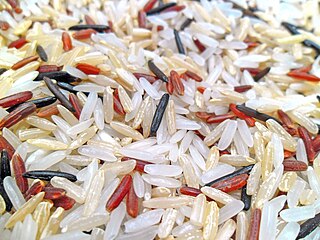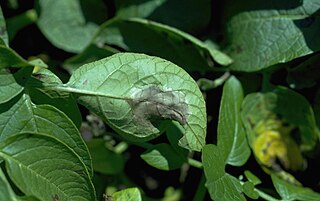Related Research Articles

The potato is a starchy food, a tuber of the plant Solanum tuberosum and is a root vegetable native to the Americas. The plant is a perennial in the nightshade family Solanaceae.

Rice is the seed of the grass species Oryza sativa or, less commonly, O. glaberrima. The name wild rice is usually used for species of the genera Zizania and Porteresia, both wild and domesticated, although the term may also be used for primitive or uncultivated varieties of Oryza.

Plant pathology is the scientific study of diseases in plants caused by pathogens and environmental conditions. Organisms that cause infectious disease include fungi, oomycetes, bacteria, viruses, viroids, virus-like organisms, phytoplasmas, protozoa, nematodes and parasitic plants. Not included are ectoparasites like insects, mites, vertebrate, or other pests that affect plant health by eating plant tissues and causing injury that may admit plant pathogens. Plant pathology also involves the study of pathogen identification, disease etiology, disease cycles, economic impact, plant disease epidemiology, plant disease resistance, how plant diseases affect humans and animals, pathosystem genetics, and management of plant diseases.

Phytophthora infestans is an oomycete or water mold, a fungus-like microorganism that causes the serious potato and tomato disease known as late blight or potato blight. Early blight, caused by Alternaria solani, is also often called "potato blight". Late blight was a major culprit in the 1840s European, the 1845–1852 Irish, and the 1846 Highland potato famines. The organism can also infect some other members of the Solanaceae. The pathogen is favored by moist, cool environments: sporulation is optimal at 12–18 °C (54–64 °F) in water-saturated or nearly saturated environments, and zoospore production is favored at temperatures below 15 °C (59 °F). Lesion growth rates are typically optimal at a slightly warmer temperature range of 20 to 24 °C.
Blight refers to a specific symptom affecting plants in response to infection by a pathogenic organism.
Fungicides are pesticides used to kill parasitic fungi or their spores. They are most commonly chemical compounds, but may include biocontrols and fungistatics. Fungi can cause serious damage in agriculture, resulting in critical losses of yield, quality, and profit. Fungicides are used both in agriculture and to fight fungal infections in animals. Fungicides are also used to control oomycetes, which are not taxonomically/genetically fungi, although sharing similar methods of infecting plants. Fungicides can either be contact, translaminar or systemic. Contact fungicides are not taken up into the plant tissue and protect only the plant where the spray is deposited. Translaminar fungicides redistribute the fungicide from the upper, sprayed leaf surface to the lower, unsprayed surface. Systemic fungicides are taken up and redistributed through the xylem vessels. Few fungicides move to all parts of a plant. Some are locally systemic, and some move upward.

Magnaporthe grisea, also known as rice blast fungus, rice rotten neck, rice seedling blight, blast of rice, oval leaf spot of graminea, pitting disease, ryegrass blast, Johnson spot, neck blast, wheat blast and Imochi (稲熱), is a plant-pathogenic fungus and model organism that causes a serious disease affecting rice. It is now known that M. grisea consists of a cryptic species complex containing at least two biological species that have clear genetic differences and do not interbreed. Complex members isolated from Digitaria have been more narrowly defined as M. grisea. The remaining members of the complex isolated from rice and a variety of other hosts have been renamed Magnaporthe oryzae, within the same M. grisea complex. Confusion on which of these two names to use for the rice blast pathogen remains, as both are now used by different authors.

Steven Dale Tanksley is the Chief Technology Officer of Nature Source Improved Plants. Prior to founding Nature Source Improved Plants, Tanksley served as the Liberty Hyde Bailey professor of plant breeding and biometry and chair of the Genomics Initiative Task Force at Cornell University College of Agriculture and Life Sciences. He is currently a Professor Emeritus at Cornell University.
Spot blotch is a leaf disease of wheat caused by Cochliobolus sativus. Cochliobolus sativus also infects other plant parts and in conjunction with other pathogens causes common root rot and black point.

Rhizoctonia solani is a species of fungus in the order Cantharellales. Basidiocarps are thin, effused, and web-like, but the fungus is more typically encountered in its anamorphic state, as hyphae and sclerotia. The name Rhizoctonia solani is currently applied to a complex of related species that await further research. In its wide sense, Rhizoctonia solani is a facultative plant pathogen with a wide host range and worldwide distribution. It causes various plant diseases such as root rot, damping off, and wire stem. It can also form mycorrhizal associations with orchids.
Marker assisted selection or marker aided selection (MAS) is an indirect selection process where a trait of interest is selected based on a marker linked to a trait of interest, rather than on the trait itself. This process has been extensively researched and proposed for plant- and animal- breeding.

Plant disease resistance protects plants from pathogens in two ways: by pre-formed structures and chemicals, and by infection-induced responses of the immune system. Relative to a susceptible plant, disease resistance is the reduction of pathogen growth on or in the plant, while the term disease tolerance describes plants that exhibit little disease damage despite substantial pathogen levels. Disease outcome is determined by the three-way interaction of the pathogen, the plant and the environmental conditions.

Pamela Christine Ronald is an American plant pathologist and geneticist. She is a professor in the Department of Plant Pathology and the Genome Center at the University of California, Davis and a member of the Innovative Genomics Institute at the University of California, Berkeley. She also serves as Director of Grass Genetics at the Joint BioEnergy Institute in Emeryville, California. In 2018 she served as a visiting professor at Stanford University in the Center on Food Security and the Environment.

Xanthomonas oryzae pv. oryzae is a bacterial pathovar that causes a serious blight of rice, other grasses, and sedges.

A genetically modified potato is a potato that has had its genes modified, using genetic engineering. Goals of modification include introducing pest resistance, tweaking the amounts of certain chemicals produced by the plant, and to prevent browning or bruising of the tubers. Varieties modified to produce large amounts of starches may be approved for industrial use only, not for food.
Induced Systemic Resistance (ISR) is a resistance mechanism in plants that is activated by infection. Its mode of action does not depend on direct killing or inhibition of the invading pathogen, but rather on increasing physical or chemical barrier of the host plant. Like the Systemic Acquired Resistance (SAR) a plant can develop defenses against an invader such as a pathogen or parasite if an infection takes place. In contrast to SAR which is triggered by the accumulation of salicylic acid, ISR instead relies on signal transduction pathways activated by jasmonate and ethylene.
The Vertifolia effect is a well documented phenomenon in the fields of plant breeding and plant pathology. It is characterized by the erosion of a crop’s horizontal resistance to disease during a breeding cycle due to the presence of strong vertical resistance, characterized by the presence of R genes. This effect was observed in late blight of potato. This phenomenon was first described by J.E. Van der Plank in his 1963 book Plant Disease: Epidemics and Control. Van der Plank observed that under artificial selection the potato variety Vertifolia had stronger vertical resistance to the potato late blight pathogen, Phytophthora infestans, as measured by the presence of specific R genes. However, when the pathogen overcame these R genes Vertifolia exhibited a greater loss of horizontal resistance than varieties with fewer R genes and lower vertical resistance. This effect suggests that when a pathogen evolves an avirulence gene to counteract a variety’s R gene, that variety will be more susceptible to the pathogen than other varieties.
Molly Jahn is an American plant geneticist and breeder and Professor of Agronomy at University of Wisconsin-Madison, USA. She was Under Secretary of Research, Education and Economics in the U.S. Department of Agriculture.
Samuel S. Gnanamanickam is an Indian plant pathologist. He is known for his research on diversity of rice pathogens, molecular breeding of indica rices for disease resistance and for developing superior strains of beneficial strains of rhizosphere bacteria for biological control of rice diseases. He is a fellow of the National Academy of Agricultural Sciences and National Academy of Biological Sciences of India and was Chair of the biological control committee at the American Phytopathological Society. He was named by Marquis Who's Who as a noteworthy plant pathologist.

Awais Khan is a Pakistani-American plant geneticist and an associate professor at the College of Agriculture and Life Sciences, Cornell University.
References
- ↑ "MacArthur Foundation". www.macfound.org.
- ↑ "Rebecca Nelson | Plant Pathology and Plant-Microbe Biology Section". pppmb.cals.cornell.edu. Retrieved 2015-12-15.
- ↑ "Homelands Productions | Homelands Productions Jonathan Miller". www.homelands.org. Retrieved 2017-09-28.
- ↑ "Nelson, Rebecca J." vivo.cornell.edu. Retrieved 2015-12-15.
- ↑ "Rebecca J. Nelson — MacArthur Foundation". www.macfound.org. Retrieved 2015-12-15.
- ↑ "Nelson Lab: Home". www.plantpath.cornell.edu. Retrieved 2015-12-15.